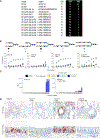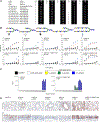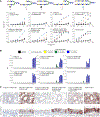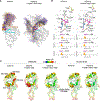Epistasis in the receptor-binding domain of contemporary H3N2 viruses that reverted to bind sialylated di-LacNAc repeats
- PMID: 40679911
- PMCID: PMC12439434
- DOI: 10.1016/j.celrep.2025.116007
Epistasis in the receptor-binding domain of contemporary H3N2 viruses that reverted to bind sialylated di-LacNAc repeats
Abstract
Since their introduction into humans, H3N2 influenza A viruses have evolved continuously to escape immunity through antigenic drift, driven by mutations in and around the receptor-binding site. Recently, these changes resulted in viruses that recognize elongated glycans, which are less abundant in the human respiratory tract, complicating vaccine strain propagation. This study employed ELISA, glycan arrays, tissue staining, flow cytometry, and hemagglutinin (HA) assays to demonstrate the molecular determinants of recent H3N2 viruses that regained recognition of shorter glycans. Mutations Y159N/T160I in contemporary strains replace Y159/T160, weakening receptor binding. However, this is compensated by Y195F in the 190-helix. These findings highlight epistasis across critical residues in the HA receptor-binding site, including the 130-loop, 150-loop, and 190-helix. Interestingly, a positive correlation exists between binding to an asymmetrical N-glycan and binding to human and ferret respiratory tract tissues. These results elucidate the epistatic nature of receptor-binding specificity during influenza A virus H3N2 evolution.
Keywords: CP: Microbiology; H3N2; N-glycan; epistasis; hemagglutinin; influenza; receptor binding; sialic acid.
Copyright © 2025 The Authors. Published by Elsevier Inc. All rights reserved.
Conflict of interest statement
Declaration of interests The authors declare no competing interests.
Figures






Update of
-
Epistasis in the receptor binding domain of contemporary H3N2 viruses that reverted to bind sialylated diLacNAc repeats.bioRxiv [Preprint]. 2024 Nov 26:2024.11.26.625384. doi: 10.1101/2024.11.26.625384. bioRxiv. 2024. Update in: Cell Rep. 2025 Aug 26;44(8):116007. doi: 10.1016/j.celrep.2025.116007. PMID: 39651261 Free PMC article. Updated. Preprint.
References
-
- Fouchier RAM, Munster V, Wallensten A, Bestebroer TM, Herfst S, Smith D, Rimmelzwaan GF, Olsen B, and Osterhaus ADME (2005). Characterization of a novel influenza A virus hemagglutinin subtype (H16) obtained from black-headed gulls. J. Virol. 79, 2814–2822. 10.1128/jvi.79.5.2814-2822.2005. - DOI - PMC - PubMed
-
- West J, Röder J, Matrosovich T, Beicht J, Baumann J, Mounogou Kouassi N, Doedt J, Bovin N, Zamperin G, Gastaldelli M, et al. (2021). Characterization of changes in the hemagglutinin that accompanied the emergence of H3N2/1968 pandemic influenza viruses. PLoS Pathog. 17, e1009566. 10.1371/journal.ppat.1009566. - DOI - PMC - PubMed
-
- Koel BF, Burke DF, Bestebroer TM, van der Vliet S, Zondag GCM, Vervaet G, Skepner E, Lewis NS, Spronken MIJ, Russell CA, et al. (2013). Substitutions near the receptor binding site determine major antigenic change during influenza virus evolution. Science 342, 976–979. 10.1126/science.1244730. - DOI - PubMed
MeSH terms
Substances
Grants and funding
LinkOut - more resources
Full Text Sources
Miscellaneous

